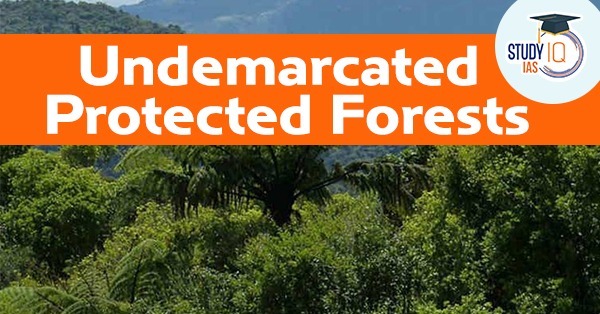Table of Contents
Forests
- There is no clear nationally-accepted definition of ‘forest’. States have to determine what constitutes forests.
- In T.N. Godavarman Thirumulkpad vs the Union of India judgment, the Supreme Court interpreted that the word “forest” based on its “dictionary meaning”.
- This definition covers all statutorily recognised forests, whether designated as reserved, protected or otherwise.
Undemarcated Protected Forests Current Issue
- Lack of due procedure: The Chhattisgarh government has not followed due process while transferring land from Forest to the Revenue Department.
- The state government has justified the move by saying that the areas in question were non-forest lands that were earlier given “by mistake” to the Forest Department.
- Clearance: The Union Environment ministry has described these areas as “Undemarcated Protected Forests”, which cannot be used for non-forest purposes without clearance under the Forest Conservation (FC) Act, 1980.
- Forests in Chhattisgarh: Forests cover 21% of the area in Chhattisgarh. Lack of available land is affecting development in the state.
- The state government decided to identify non-forest land with less than 200 trees per hectare which were included in “Orange Areas” under the Forest Department.
Undemarcated Protected Forests (Orange Areas):
- After abolition of zamindari, Malguzari forests came under the Revenue Department and in 1958, the government of undivided Madhya Pradesh notified all these areas as Undemarcated Protected Forests (PFs) under the Forest Department.
- Under the zamindari system, villagers used local malguzari (livelihood concessions) forests for firewood, grazing, etc
- The government of Madhya Pradesh notified these areas as Undemarcated Protected Forests in 1958.
- Surveys were conducted to either notify them as Reserve Forests or return it back to the revenue
- The parcels of land that are not yet surveyed are the Undemarcated Protected Forests and were marked in orange on the map. They were termed as orange areas.
Forests Under Indian Law:
- Forests in India are included in List III (Concurrent List) under the Seventh Schedule of the Constitution.
- Indian Forest (IF) Act, 1927: There are two types of forests–Reserve Forests (RF) and Undemarcated Protected Forests (PF).
- Reserved Forests (RF): No rights are allowed unless specified
- Protected Forests (PF): No rights are barred unless specified
- Forests Conservation Act 1980: Applicable to all kinds of forests, whether under the control of the Forest or the Revenue Department.
- Using forests for non-forest purpose such as industry, mining, or construction requires statutory clearance.
Present Challenges in Implementation of Denotification:
- Rights of Villagers: Since existence of the FC act, the state requires central clearance for non-forest use of forest land. This has led to a situation where the rights of lakhs of villagers remain restricted.
- Definition of forests: The nature of vegetation changes over time. Demarcating forests based on visual survey cannot determine if a particular piece of land did not meet the definition of forests.
Way Forward:
- Compensatory afforestation: Under Forest Conservation Act 1980, diverting forest land for non-forest purpose will require giving back twice the area for compensatory afforestation (CA) from Revenue to Forest.
- This process will defeat the very need for which the state government has acquired land.
- Exceptions: In case forest land must be converted to revenue land, there are procedures. This however is a tedious purpose.


 MPPSC FSO Recruitment Notification 2025 ...
MPPSC FSO Recruitment Notification 2025 ...
 UNESCO World Heritage Sites of India Lis...
UNESCO World Heritage Sites of India Lis...
 Consolidated Fund of India, Meaning and ...
Consolidated Fund of India, Meaning and ...





















